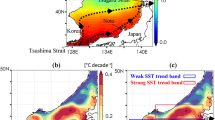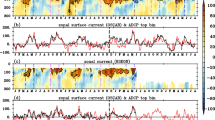Abstract
This study examines the seasonality of the patterns of the ocean mixed layer depth (MLD) with the coastal upwelling system, using a model data from marine Copernicus with a resolution of 0.083° × 0.083°. For that, we examined wind forcing, ocean circulation, sea surface temperature, sea surface salinity, sea surface chlorophyll-a, and mixed layer depth seasonality from 2007 to 2017 in the Cape Bojador south of the Moroccan Atlantic coast. We observed that in the fall season the wind speed was low, and the maximum wind speed is in the summer season. Furthermore, we found that coastal areas are related to a generally shallower MLD all the year in the Cape. We also proved that the source of the upwelling is between 25 and 26°N. However, we observed that the sea surface chlorophyll concentration in the same region is minimum, while in the region between 24.5 and 22°N, the CHL-a is maximum. We suggested that the biological richness in Cape Bojador, due to the activity of upwelling, derives to the south because of the northward ocean filament. Despite the different physical and biological parameters used to detect upwelling activity, we found that upwelling detection based on sea surface temperature is the best method to describe the upwelling activity in this region.










Similar content being viewed by others
References
Adcroft A, Hill C, Marshall J (1997) Representation of topography by shaved cells in a height coordinate ocean model. Mon Weather Rev 125:2293–2315
Amante C, Eakins BW (2009) ETOPO1 1 arc-minute global relief model: procedures, data sources and analysis. NOAA Technical Memorandum NESDIS NGDC-24, p 25
Arakawa A, Lamb VR (1981) A potential enstrophy and energy conserving scheme for the shallow water equations. Mon Weather Rev 109:18–36
Barnier B, Madec G, Penduff T, Molines JM, Treguier AM, Le Sommer J, Beckmann A, Biastoch A, Böning C, Dengg J, Derval C, Durand E, Gulev S, Remy E, Talandier C, Theetten S, Maltrud M, McClean J, De Cuevas B (2006) Impact of partial steps and momentum advection schemes in a global circulation model at eddy permitting resolution. Ocean Dyn 56:543–567
Becker JJ, Sandwell DT, Smith WHF, Braud J, Binder B, Depner J, Fabre D, Factor J, Ingalls S, Kim SH, Ladner R, Marks K, Nelson S, Pharaoh A, Trimmer R, Von Rosenberg J, Wallace G, Weatherall P (2009) Global bathymetry and elevation data at 30 arc seconds resolution: SRTM30_PLUS. Mar Geod 32:355–371. https://doi.org/10.1080/01490410903297766
Behrenfeld MJ, Boss ES (2014) Resurrecting the ecological underpinnings of ocean plankton blooms. Annu Rev Mar Sci 6:167–194
Benazzouz A et al (2014) On the temporal memory of costal upwelling off NW Africa. J Geophys Res Ocean 119:6356–6380
Bessa Ismail A, Makaoui K Hilmi, Afifi M (2017) Wavelet analysis on upwelling index along the Moroccan Atlantic coast. Eur Sci J 13(12):276
Bessa I, Makaoui A, Hilmi K, Afifi M (2018) Variability of the mixed layer depth and the ocean surface properties in the Cape Ghir region, Morocco for the period 2002–2014. Model Earth Syst Environ. https://doi.org/10.1007/s40808-018-0411-7
Boyer Montégut C et al (2004) Mixed layer depth over the global ocean: An examination of profile data and a profile-based climatology. J Geophys. https://doi.org/10.1029/2004jc002378
Brown E et al (1989) Ocean circulation. In: Bearman G (ed). Open University (2nd edn 2001, Reprinted 2004; eBook ISBN: 9780080537948, Paperback ISBN: 9780750652780)
Cravatte S, Madec G, Izumo T, Menkes C, Bozec A (2007) Progress in the 3-D circulation of the eastern equatorial Pacific in a climate. Ocean Model 17:28–48
Ducklow HW, Baker K, Martinson DG, Quetin LB, Ross RM, Smith RC, Stammerjohn SE, Vernet M, Fraser W (2007) Marine pelagic ecosystems: the west antarctic peninsula. Philos Trans R Soc Lond B Biol Sci 362(1477):67–94
Elghrib H et al (2012) Phytoplankton distribution in the upwelling areas of the Moroccan Atlantic coast localized between 32°30°N and 24°N. CR Biol. https://doi.org/10.1016/j.crvi.2012.07.002
Fichefet T, Maqueda MAM (1997) Sensitivity of a global sea ice model to the treatment of ice thermodynamics and dynamics. J Geophys Res 102(C6):12609–12646
Holte J, Talley L (2009) A new algorithm for finding mixed layer depths with applications to argo data and subantarctic mode water formation. J Atmos Ocean Technol 26(9):1920–1939
Hunke EC, Dukowicz JK (1997) An elastic-viscous-plastic model for sea ice dynamics. J Phys Oceanogr 27:1849–1867
Lévy M, Jahn O, Dutkiewicz S, Follows MJ, d’Ovidio F (2015) The dynamical landscape of marine phytoplankton diversity. J R Soc Interface 12(111):20150481
Madec G, The NEMO team (2008) NEMO ocean engine. Note du Pôle de modélisation, Institut Pierre-Simon Laplace (IPSL), France, No. 27. ISSN 1288-1619
Madec G, Imbard M (1996) A global ocean mesh to overcome the North Pole singularity. Clim Dyn 12:381–388
Makaoui A et al (2005) L’upwelling de la côte atlantique du Maroc entre 1994 et 1998. Comptes Rendus Geoscience 337(16):1518–1524
Mitchell BG, Holm-Hansen O (1991) Observations of modeling of the Antartic phytoplankton crop in relation to mixing depth. Deep Sea Res Part A Oceanogr Res Pap 38(8):981–1007
Pastor MV, Peña‐Izquierdo J, Pelegrí JL, Marrero‐Díaz A (2012) Meridional changes in water properties off NW during November 2007/2008. Cienc Mar 38:223–244
Pellichero V, Sallée J-B, Schmidtko S, Roquet F, Charrassin J-B (2016) The ocean mixed-layer under Southern Oceansea-ice: seasonal cycle and forcing. J Geophys Res Oceans. https://doi.org/10.1002/2016JC011970
Reynolds R, Smith T, Liu C, Chelton D, Casey K, Schlax M (2007) Daily high-resolution-blended analyses for sea surface temperature. J Clim 20:5473–5496
Rosell-Fieschi M, Pelegri JL, Gourrion J (2015) Zonal jets in the equatorial Atlantic Ocean. Prog Oceanogr 130:1–18
Roullet G, Madec G (2000) Salt conservation, free surface, and varying levels: a new formulation for ocean general circulation models. J Geophys Res 105:23927–23942
Smith W, Jones RM (2015) Vertical mixing, critical depths, and phytoplankton growth in the Ross Sea. ICES J Mar Sci J du Conseil 72(6):1952–1960. https://doi.org/10.1093/icesjms/fsu234
Stranne C et al (2018) Acoustic mapping of mixed layer depth. Ocean Sci Discuss. https://doi.org/10.5194/os-2017-103
Sverdrup HU (1953) On vernal blooming of phytoplankton. J Conseil Exp Mer 18:287–295
Whitworth T, Orsi A, Kim SJ, Nowlin W, Locarnini R (1998) Water masses and mixing near the antarctic slope front. Ocean Ice Atmos Interact Antarctic Cont Mar 75:1–27
Acknowledgements
With regard to the sources of data presented in this article, the authors express their gratitude to Copernicus-Marine Environment Monitoring Services.
Author information
Authors and Affiliations
Corresponding author
Additional information
Publisher's Note
Springer Nature remains neutral with regard to jurisdictional claims in published maps and institutional affiliations.
Appendix
Appendix
Rights and permissions
About this article
Cite this article
Bessa, I., Makaoui, A., Agouzouk, A. et al. Variability of the ocean mixed layer depth and the upwelling activity in the Cape Bojador, Morocco. Model. Earth Syst. Environ. 6, 1345–1355 (2020). https://doi.org/10.1007/s40808-020-00774-1
Received:
Accepted:
Published:
Issue Date:
DOI: https://doi.org/10.1007/s40808-020-00774-1








